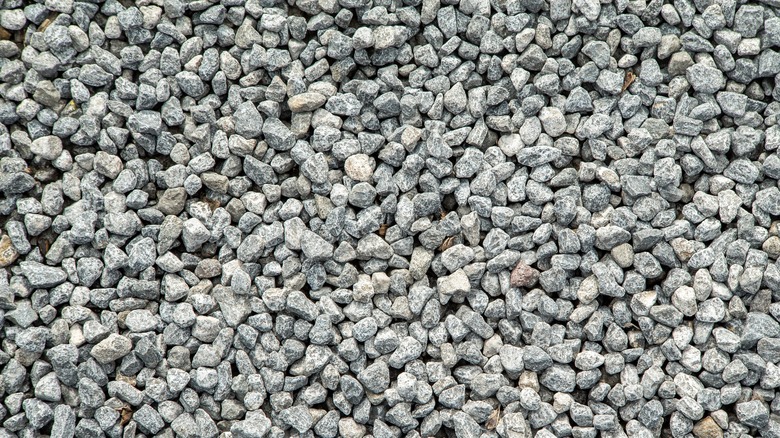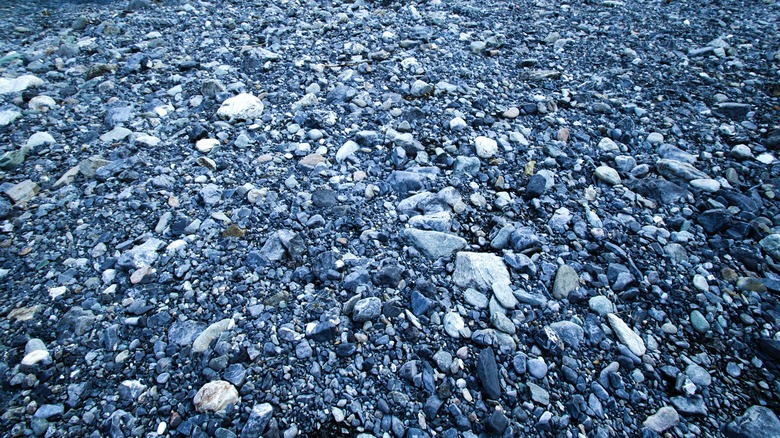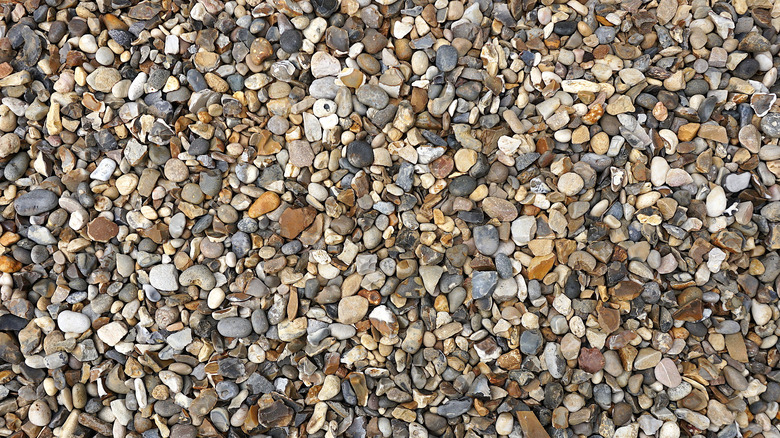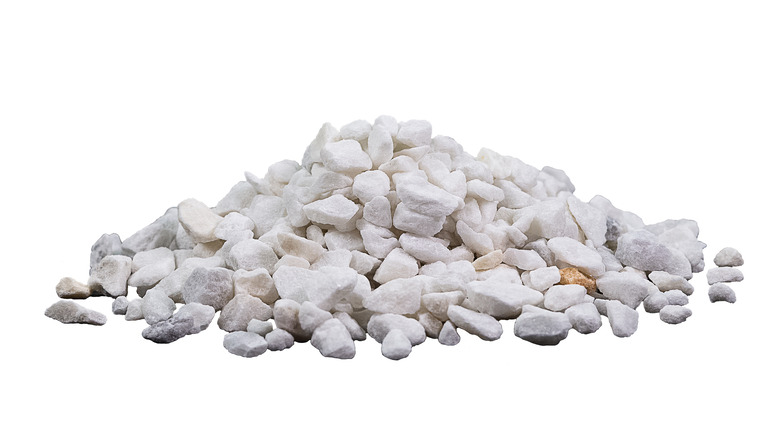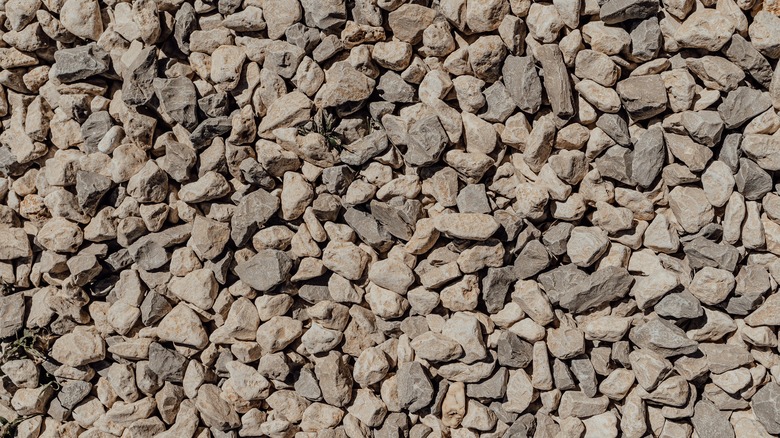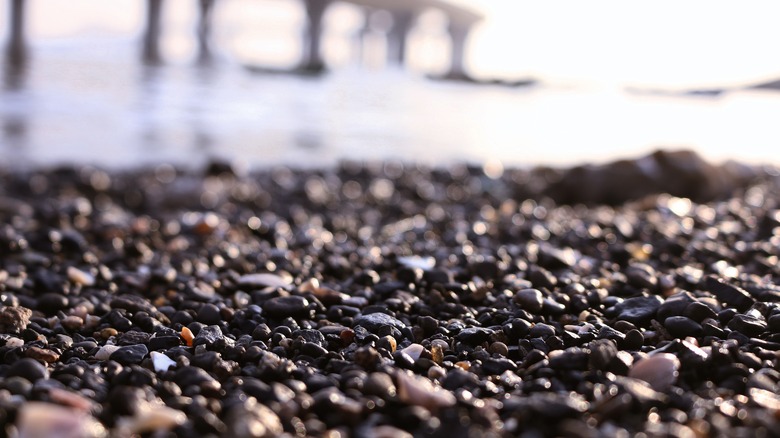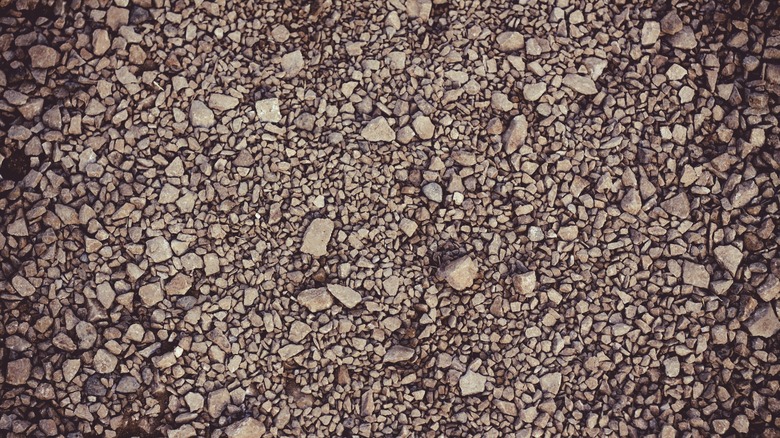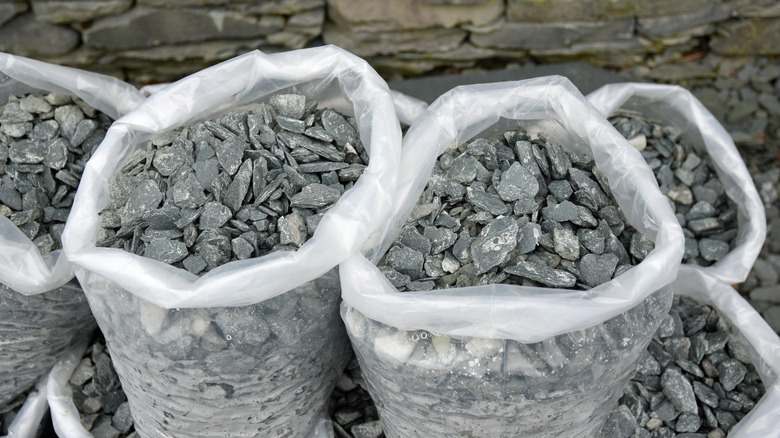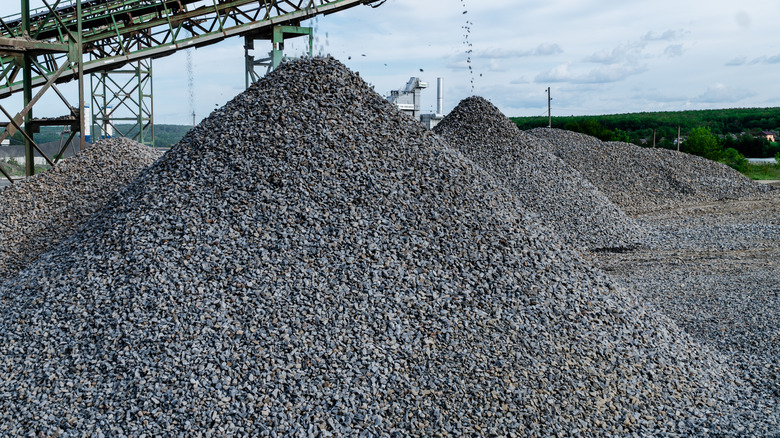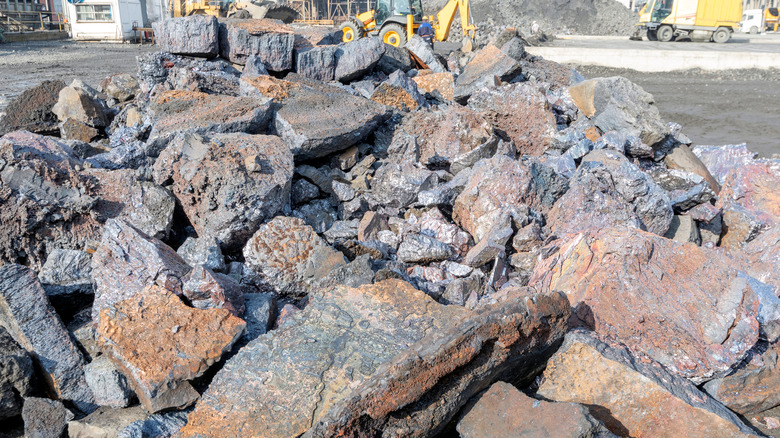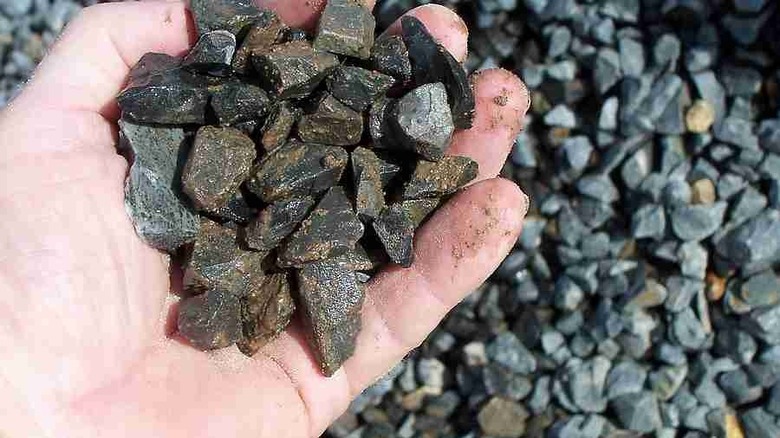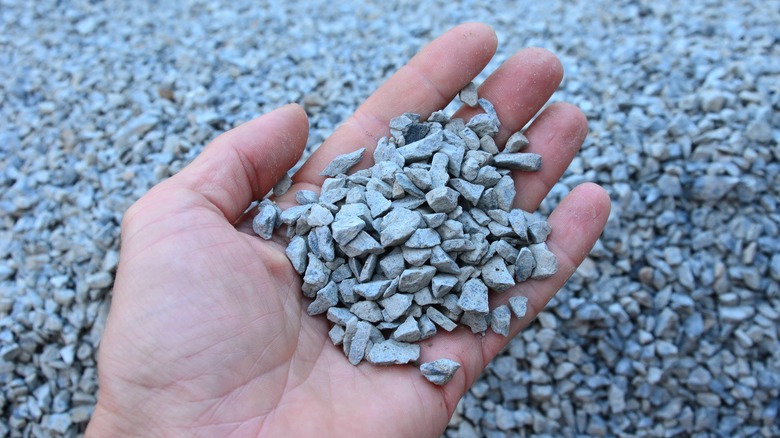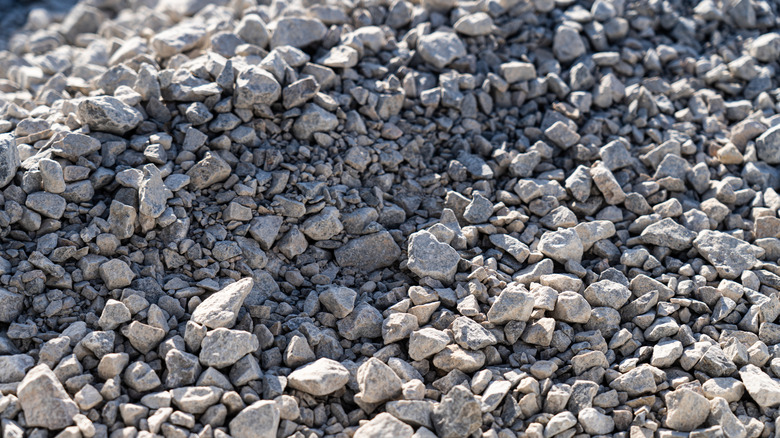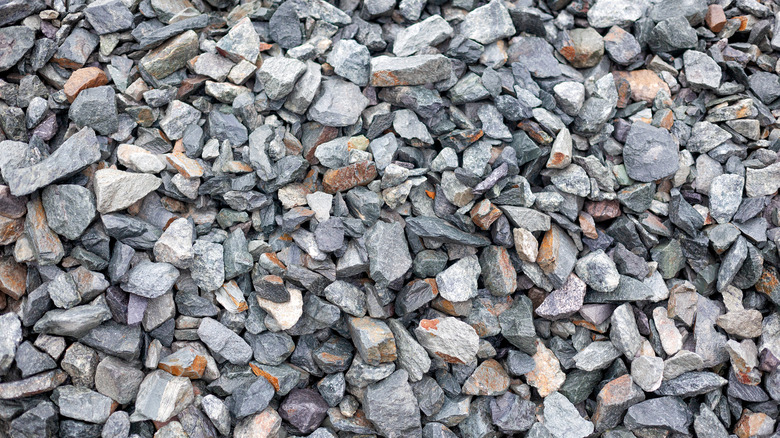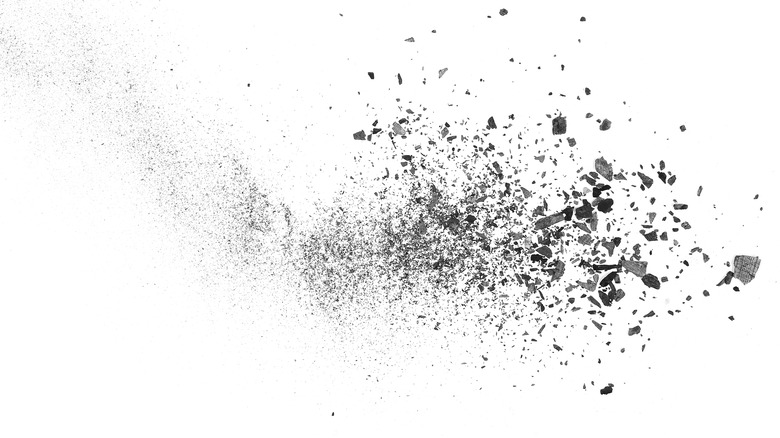What Are The Different Types Of Gravel To Consider
There are many reasons to choose gravel as your landscaping material. For one, Bob Vila tells us it requires less water usage, especially when you compare it to grass. It's also fairly environmentally friendly and lasts longer than other materials with minimal maintenance.
If you're looking to save some money, gravel is the material for you; Angi estimates gravel averages around $1.25 to $1.80 per square foot (without professional installation). If you have DIY experience, you likely won't need professionals to install it, especially for smaller projects. For larger projects, like gravel driveways, you may choose professionals for convenience and time-savings.
Rocks are rocks, right? Actually, there are many types of gravel to consider for your project. Each type of gravel will have variations in shape, durability, and cost. To that end, having a general understanding of the most common types of gravel can help you choose the best gravel for your project.
River rock gravel
Combining form and function, river rock gravel is an aesthetically pleasing choice beloved by homeowners. Lumber Jake says it's an easy gravel to use, not requiring much preparation, with minimal maintenance and an easy self-install.
While river rock gravel provides excellent drainage, it won't compact as well as others; Bob Vila says it's not a great choice for driveways or walkways. The larger pieces can be less stable and can quickly be displaced when driven on.
Pea gravel
Arguably the most popular type of gravel, pea gravel, is extremely versatile and typically inexpensive, according to DoItYourself. It provides a drier surface because it facilitates better drainage. For that reason, it's a top choice for projects like driveways and playgrounds.
Bob Vila explains because of the shape and composition of pea gravel, water soaks immediately into the ground, rather than running over top. Along with keeping the area cleaner and less muddy, this also prevents erosion.
Marble chips
Great for classier walking paths and patios, a key feature of marble chips, says SFGate, is their reflective surface. They brilliantly reflect light, brightening your yard. However, they're a bad choice in garden beds where the reflected sun can be too much for plants. They can also affect your plants on a chemical level.
Favored Stone Guides explains marble chips add salts and chemicals to your garden. These can reach roots, slowing growth as plants essentially starve, or cause root rot.
Crushed stone gravel
The name tells you everything: Crushed stone is gravel made from larger stones being, well, crushed. The defining characteristic of crushed stone is that it's human-made, as noted by The Spruce. It ranges from ¾ to 4 inches so there's an option for any project.
Crushed stone is known for its versatility and low price. Additionally, a 2020 U.S. Geological Society estimate shared that the U.S. produces about 1.46 billion tons of crushed stone annually, or 4 tons of crushed rock per citizen.
Jersey Shore gravel
The story of Jersey Shore gravel is millions of years old, says Kenneth Miller, graduate program director at Rutgers University's Department of Earth and Planetary Science. Miller explained to Bronx News 12 the popular east-coast gravel comes from long-term erosion of the Appalachian Mountains.
HomeAdvisor describes it as rounded in shape and available in earthy colors, though it's known for its yellow variety. You will need to add edging, as it won't compact as well as other more jagged types of gravel.
Bank run gravel
Available in brown and gray, Connect2Local explains bank run gravel is a composite of several aggregates. Specifically, bank run gravel is a mixture of rocks, dirt, silt, sand, and miscellaneous stone particles.
ReAgg credits river banks as the main source of bank run gravel. It will work well as a private driveway or backyard pathway. It naturally compacts well because of the combination of components. This will result in greater stability and long-term durability.
Slate gravel and chips
Known for versatility, Bob Vila recommends slate chips or slate gravel when building a pathway, adding edging, building a driveway, or adding mulch to your garden. Because organic mulch attracts bugs, many gardeners are switching to non-organic slate chips.
Decorative Aggregates elaborates on the benefits of slate chip gravel, praising its durability and ability to regulate soil, making it an excellent option in your garden during the hot summer months. For a flatter result, choose ¾-inch chips.
Quarry process
The Millennial Homeowner writes quarry process is the most basic and inexpensive gravel option. However, that low price doesn't offer consistency or uniformity in particle size. You won't know how your project will look until that final stone is placed.
Sparta Block Mason Materials recommends it for walkways, bike paths, or as a base because this gravel naturally compacts and solidifies. It has larger percentages of stone dust than other gravels and the lack of uniformity means it will lock together easily, allowing for a variety of projects for the backyard makeover of your dreams.
Slag gravel
For the environmentally-concious homeowner, slag gravel is the option for you. The Millennial Homeowner explains it tends to be heavier than other gravels, but different slag gravels have different compositions, influenced by the steel it's taken from.
Slag's popularity has grown so much, as the U.S. Department of Transportation Federal Highway Administration has noted. They estimate 7 to 7.5 metric tons of slag are produced annually in the U.S. and recommend using it as a base.
Traprock gravel
Traprock is inherently ambiguous. Geology.com explains the term traprock is a construction term indicating an unspecified stone. This unassuming option is carving out its place in the industry, accounting for about 7% of the crushed stone produced in the U.S., or 88 million tons annually.
Connect2Local recommends traprock for driveways, roads, walkways, to add drainage, and for traction. Particularly useful in driveways, traprock's traction makes it a great option for areas that often experience freezing temperatures.
Item #4 gravel
According to HouseGrail, the name #4 gravel refers to its composition. Interestingly, there is a recycled option created from recycled concrete, blacktop, bricks, rocks, and other stones.
Designing Ideas says it's an excellent choice for the middle layer of your driveway. As a mixture of stone, sand and clay, the 1 to 2.5 inch pieces will shift more solidify more than other materials because of the sand. You still may need an additional stabilizer or binder.
#57 gravel
#57 gravel is a top choice when it comes to drainage. Dirt Connection explains #57 indicates the size of the material, which is sorted to about 1 to 1.5 inches in diameter. It's typically a composite of many stone types, including granite, quartzite, limestone, and others.
Its angular shape, FarmFoodFamily explains, makes it a top choice for drainage projects; it allows water to flow while preventing individual particles from becoming stuck together or embedded in the soil.
Decomposed granite
Decomposed granite, often confused for basic gravel, is one of the best choices for a stable surface, according to Bob Vila. It's smaller than traditional gravel, measuring about ¾ inch around. It naturally compacts and when you tamp it down, it can become as stable as concrete, but still provides drainage.
Houzz recommends using decomposed granite in thin layers, watering and tamping each layer down before adding more. Adding a stabilizer can protect against damage from traffic or weather.
Stone dust
Stone dust, also known as polymeric sand according to The Spruce, is primarily a binder. Hollywood Hills Rehab explains it was considered a waste material until builders realized it's usefulness. Today we know stone dust can be utilized in any hardscaping project, says Nimvo.
Using stone dust creates a flat, smooth surface at a lower cost. This is a non-porous material, making it great for projects directing water, like filling spaces between pavers, but not in those requiring drainage.
